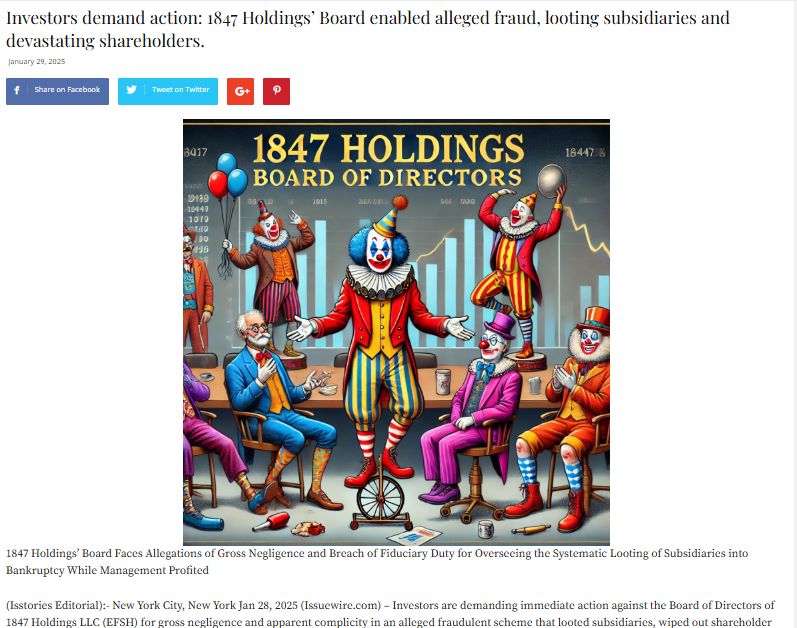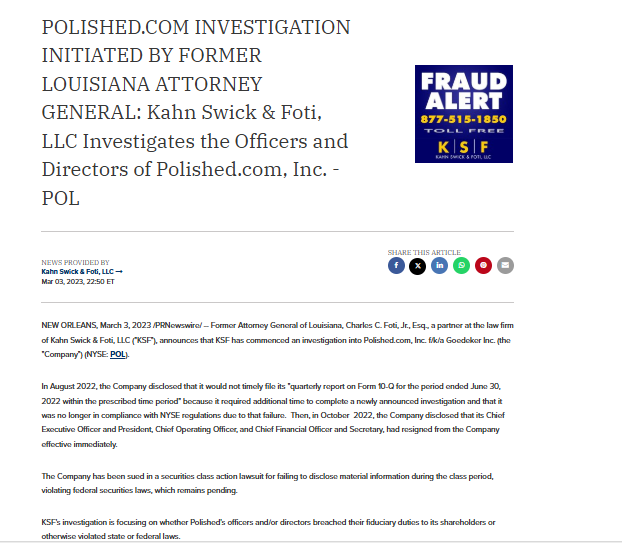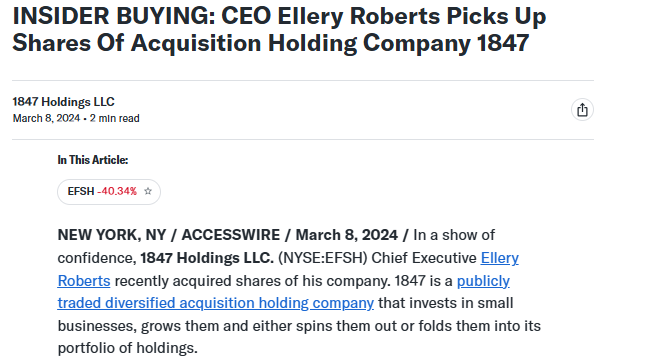In the world of publicly traded companies, trust is the foundation upon which investors place their capital. However, 1847 Holdings LLC, a company that presents itself as a diversified holding entity, has been accused of betraying that trust in the most egregious manner. Alongside its spinoff, Polished.com, 1847 Holdings is alleged to be a meticulously engineered Ponzi scheme, designed not to build sustainable businesses but to fleece investors through a relentless cycle of financial manipulation. At the center of this operation are key figures like Ellery Roberts, a seasoned executive with a questionable track record, and Louis A. Bevilacqua, a lawyer whose dual role as legal counsel and financial beneficiary raises serious ethical concerns. This article delves into the intricate mechanisms of 1847 Holdings’ alleged fraud, exposing how reverse stock splits, questionable dividends, and systematic financial engineering have allowed this scheme to persist indefinitely.
The Anatomy of the Alleged Fraud
A Public Company Disguised as a Ponzi Scheme
Ponzi schemes are typically associated with private ventures or shadowy investment funds, not publicly traded companies subject to regulatory oversight. Yet, 1847 Holdings defies this norm by allegedly exploiting its public status to lure investors into a false sense of security. The company, listed on the OTC markets, presents itself as a holding company acquiring and managing small to mid-sized businesses across various sectors. However, a closer examination reveals a starkly different reality: a company engineered to raise vast sums of capital while systematically destroying shareholder value.
Since its inception, 1847 Holdings has raised nearly $700 million through various capital raises, including equity offerings and debt financings, alongside its spinoff, Polished.com. This staggering amount of money, however, has not translated into growth, profitability, or sustainable operations. Instead, the vast majority of these funds have seemingly vanished, leaving behind a trail of bankrupt subsidiaries, mounting debt, and a stock price that has plummeted to near-worthless levels. The company’s split-adjusted stock price, which once reached a high of $95,000 per share, now languishes at just $0.13—a loss of nearly 100% of its value.

The Role of Reverse Stock Splits
At the heart of 1847 Holdings’ alleged scheme is its relentless use of reverse stock splits, a financial maneuver that consolidates outstanding shares to artificially inflate the stock price. While reverse splits are sometimes used by struggling companies to meet exchange listing requirements, 1847 Holdings has executed eight such splits, four of which occurred within a mere fourteen months. This frequency is unprecedented and serves as a glaring red flag.
Each reverse split wipes out existing shareholders by drastically reducing the number of shares they hold while simultaneously resetting the share count to allow for new capital raises. For example, a 1-for-100 reverse split reduces 100 shares to 1, effectively erasing 99% of a shareholder’s position in terms of share count. While the stock price may temporarily rise to reflect the reduced share count, the underlying value of the company remains unchanged—or, in 1847 Holdings’ case, continues to deteriorate. This cycle of reverse splits and capital raises creates a reset button that allows the company to perpetuate its alleged fraud indefinitely.
Unlike a traditional Ponzi scheme, which collapses when new money stops flowing, 1847 Holdings’ reverse splits ensure that the scam can continue as long as new investors can be enticed to inject capital. By maintaining compliance with OTC listing requirements through these splits, the company avoids delisting and keeps the cycle of deception alive. This is not a business model—it’s financial engineering designed to fleece investors without end.
The Dividend Deception
Another hallmark of 1847 Holdings’ alleged fraud is its issuance of dividends despite lacking the financial foundation to support them. Dividends are typically paid by profitable companies with stable cash flows, serving as a reward to shareholders for their investment. However, 1847 Holdings has consistently reported losses, negative cash flows, and a precarious financial position, raising serious questions about the purpose of its dividends.
These dividends, far from being a sign of financial health, appear to have been issued to create a false impression of stability and growth. By distributing small cash payments to shareholders, 1847 Holdings likely aimed to bolster investor confidence and attract new capital, even as its underlying businesses crumbled. The dividends served no legitimate business purpose and instead functioned as a manipulative tactic to mask the company’s dire financial reality.

The Bankruptcy Trail
The subsidiaries acquired by 1847 Holdings tell a grim story of failure and mismanagement. The company’s business model ostensibly involves acquiring small businesses, improving their operations, and generating value for shareholders. In practice, however, nearly every acquired business has either gone bankrupt or been saddled with unsustainable debt. This pattern of failure is not coincidental but rather a feature of the alleged fraud.
The bankruptcy of these subsidiaries serves a dual purpose: it allows 1847 Holdings to write off losses while distancing itself from the failed ventures, and it creates a narrative of “unfortunate market conditions” to deflect scrutiny. Meanwhile, the capital raised to acquire and “manage” these businesses has largely disappeared, with little to show in terms of tangible assets or operational success. This systematic collapse of acquired businesses points to a deliberate strategy of financial extraction rather than genuine business development.
The Key Players
Ellery Roberts: The Serial Con Man
Ellery Roberts, the CEO of 1847 Holdings, is a central figure in the alleged fraud. With a history of involvement in questionable financial ventures, Roberts has been described as a serial con man who specializes in constructing companies designed to enrich insiders at the expense of public investors. His leadership of 1847 Holdings has been marked by aggressive capital raises, reverse stock splits, and a trail of failed subsidiaries, all of which align with the characteristics of a Ponzi scheme.
Roberts’ track record raises serious concerns about his intentions. Prior to 1847 Holdings, he was involved in other ventures that followed a similar pattern of raising capital, acquiring businesses, and ultimately failing to deliver value to shareholders. His ability to navigate the complexities of public markets while allegedly orchestrating a fraudulent scheme underscores the sophistication of the operation.
Louis A. Bevilacqua: The Conflicted Counsel
Louis A. Bevilacqua, through his law firm Bevilacqua PLLC, serves as legal counsel to both 1847 Holdings and Polished.com. Simultaneously, Bevilacqua is an investor in 1847 Holdings’ external management company, a position that provides him with a direct financial stake in the company’s operations. This dual role as both legal advisor and financial beneficiary creates a glaring conflict of interest, placing Bevilacqua at the center of the alleged fraud.
As legal counsel, Bevilacqua is responsible for ensuring that 1847 Holdings complies with securities laws and regulations. However, his financial interest in the company’s success raises questions about his objectivity and whether his legal advice prioritizes the interests of shareholders or those of the company’s insiders. The combination of his legal expertise and financial stake makes Bevilacqua a key enabler of the alleged scheme, allowing 1847 Holdings to navigate regulatory scrutiny while continuing its cycle of deception.
Polished.com: The Spinoff Scam
Polished.com, a spinoff of 1847 Holdings, mirrors its parent company’s alleged fraudulent practices. Initially presented as an e-commerce platform specializing in home appliances, Polished.com raised significant capital through public offerings, only to see its stock price collapse and its operations falter. Like 1847 Holdings, Polished.com has been accused of using reverse stock splits and questionable financial maneuvers to maintain the appearance of viability while enriching insiders.
The connection between 1847 Holdings and Polished.com is not merely structural but deeply intertwined, with shared leadership, legal counsel, and financial strategies. The spinoff appears to have been created as an additional vehicle for raising capital and perpetuating the alleged Ponzi scheme, allowing the architects of the fraud to expand their reach while maintaining the same playbook of reverse splits, dividends, and subsidiary failures.

The Mechanics of an Endless Scam
Poor Internal Controls
One of the most concerning aspects of 1847 Holdings’ operations is its consistently poor internal controls. Public companies are required to maintain robust systems for financial reporting and compliance, yet 1847 Holdings has repeatedly disclosed weaknesses in its internal controls, ranging from inadequate documentation to insufficient oversight. These deficiencies are not merely oversights but appear to be deliberate, providing a convenient excuse for financial irregularities and shielding the company from accountability.
Poor internal controls enable 1847 Holdings to obscure the true destination of the $700 million it has raised. Without transparent accounting practices, it becomes nearly impossible for investors oraiently track the flow of funds, leaving shareholders in the dark about how their money is being used. This lack of transparency is a critical component of the alleged fraud, allowing 1847 Holdings to operate with impunity.
The Reset Button: Reverse Splits and Capital Raises
The cycle of reverse stock splits and capital raises is the engine that drives 1847 Holdings’ alleged Ponzi scheme. Every three to four months, the company executes a reverse split, wiping out existing shareholders and resetting the share count. This allows 1847 Holdings to issue new shares at a higher price, raising fresh capital from unsuspecting investors. The newly raised funds are then used to sustain the company’s operations, pay dividends, or acquire new subsidiaries—none of which generate sustainable value.
This cycle creates a self-perpetuating scam that shows no signs of stopping. As long as 1847 Holdings can continue to find new investors willing to buy its shares, the scheme can persist indefinitely. The reverse splits ensure that the stock price remains above the minimum threshold for OTC listing, while the capital raises provide the cash needed to keep the operation afloat. This combination of financial maneuvers is what sets 1847 Holdings apart from traditional Ponzi schemes, making it a corporate fraud with no natural endpoint.
The Human Cost
The financial devastation wrought by 1847 Holdings extends far beyond numbers on a balance sheet. Thousands of investors, ranging from retail traders to institutional funds, have seen their investments obliterated by the company’s actions. For many, the losses represent life savings, retirement funds, or capital intended for future generations. The emotional toll of being defrauded by a company that promised growth and stability cannot be overstated.
Moreover, the employees of 1847 Holdings’ subsidiaries have also suffered. As businesses acquired by the company spiral into bankruptcy, workers lose their jobs, livelihoods, and sense of security. The ripple effects of 1847 Holdings’ alleged fraud touch countless lives, leaving a trail of financial ruin and broken trust in its wake.
Regulatory Oversight and Accountability
The persistence of 1847 Holdings’ alleged fraud raises serious questions about the effectiveness of regulatory oversight. The Securities and Exchange Commission (SEC) and other regulatory bodies are tasked with protecting investors from fraudulent schemes, yet 1847 Holdings has operated for years without significant intervention. This lack of action may be due to the complexity of the scheme, which hides behind the veneer of a legitimate public company, or the limited resources available to regulators.
However, the scale of the alleged fraud $700 million raised, eight reverse splits, and a trail of bankrupt subsidiaries demands scrutiny. Investors deserve answers about how such a scheme was allowed to persist and what steps will be taken to hold those responsible accountable. Without meaningful regulatory action, companies like 1847 Holdings will continue to exploit the public markets, leaving more victims in their wake.

Conclusion
1847 Holdings LLC and its spinoff, Polished.com, represent a new breed of corporate fraud—one that combines the deceptive allure of a Ponzi scheme with the structural advantages of a publicly traded company. Through a relentless cycle of reverse stock splits, questionable dividends, and systematic financial engineering, the company has raised nearly $700 million while delivering nothing but losses to its shareholders. At the center of this alleged scam are Ellery Roberts and Louis A. Bevilacqua, whose leadership and conflicted roles have enabled the scheme to thrive.
What makes 1847 Holdings particularly insidious is its built-in reset button. Unlike traditional Ponzi schemes that collapse under their own weight, 1847 Holdings uses reverse splits to wipe out shareholders and start anew, ensuring that the scam can continue as long as new capital flows in. This endless cycle of deception has destroyed countless investments and eroded trust in the public markets.
As of April 20, 2025, 1847 Holdings continues to operate, raising new capital and executing reverse splits with no apparent end in sight. For investors, the lesson is clear: diligence and skepticism are essential when navigating the world of public companies. For regulators, the challenge is to identify and dismantle schemes like 1847 Holdings before they claim more victims. Until meaningful action is taken, this corporate Ponzi scheme will remain a stark reminder of the dangers lurking in the financial markets.







